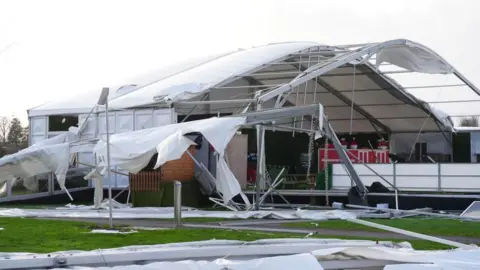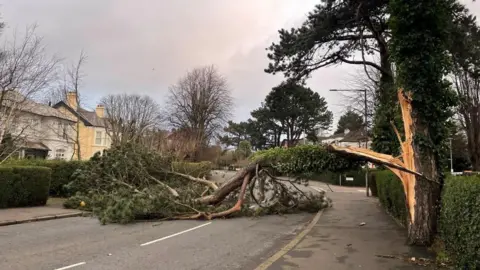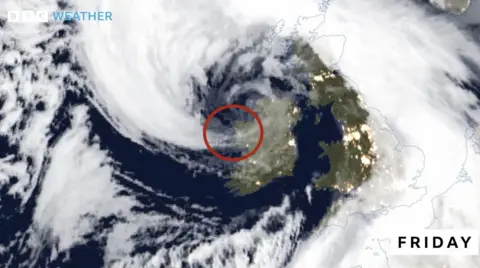BBC news
BBC weather
One person died in Ireland and hundreds of thousands of households are deprived of electricity in the United Kingdom while the Eowyn storm caused record bursts of wind.
The man died when a tree fell on his car in Donegal County, said the Gardaí (Irish police).
Ireland has experienced its strongest ever recorded gusts, causing 725,000 properties without electricity and around 138,000 people without water.
Throughout the United Kingdom, millions of people were invited to stay at home while gusts of 100 MPH (160 km/h) were recorded on Friday.
One in five flights was canceled and all the trains arrested in Scotland. All schools in Northern Ireland have been closed because the storm damaged buildings and shot down trees.
An orange wind warning remains in force for certain parts of the Scotland.
The strongest winds had passed Friday evening, but the storm was still to cause gusts of more than 128 km/h on the coast and the hills of Scotland and Northern Ireland.
Two red warnings were in force on Friday in Northern Ireland and in certain parts of Scotland.
Red is the most serious meteorological warning that the Met Office can issue, which means that dangerous weather conditions are expected and people are invited to take action to ensure their safety.
There are also yellow warnings for the wind, rain, snow and ice throughout the United Kingdom in the coming days.
Northern Ireland is in “the eye of the cyclone”, with a real threat to life and property, said Prime Minister Michelle O’Neill.
The storm has caused the strongest wind gusts for 27 years. there.
The number of private electricity properties has decreased slightly to reach 250,000, said Nie Networks, but this could take up to 10 days for everywhere to be reconnected.
Scottish Prime Minister John Swinney described the storm of “exceptional weather event” and said that a “high level of vigilance” was still required.
About 117,000 households and companies are deprived of electricity in Scotland – and around 1,200 more in Wales, according to SP Energy Networks.
Thousands of homes were also deprived of electricity in England in Northumberland, the county of Durham, Tyne and Wear and Cumbria.
There have been serious disruptions in airports, with some 1,124 flights canceled, affecting approximately 150,000 passengers, according to the Cirium aeronautical analysis company.
Dublin, Edinburgh, Heathrow and Glasgow were the most affected airports, added the press release.
A Ryanair flight which left Stansted Airport in Essex for Edinburgh reached the sky over the Scottish capital-but could not land and returned to Stansted.
 Reuters
ReutersThe bus and train services were suspended in Northern Ireland, while the Tesco supermarket chain said that all of its stores were closed and home deliveries canceled.
Ferry operators also had to cancel many crossings.
Glasgow and Edinburgh have closed all their schools. Thirty schools were closed in Northumberland, seven in Cumberland and 50 in Wales.
The maximum speed of gusts of wind in the United Kingdom, 100 MPH, was recorded in Drumalbin, in the south of Lanarkshire, in Scotland.
In Ireland, a burst of 183 km/ha was recorded in Mace Head in the county of Galway. This makes it the strongest burst of wind recorded in the country.
The Irish meteorological service puts emitted severe red time warnings – the BBC Weather saying that it could be the Irish storm of the century.
About 138,000 people across the country had no water on Friday evening, and the supply of 750,000 others was threatened, said public service company Uisce Eireann.
The electricity supply office said that there was “unprecedented damage, extended and extended to electrical infrastructure” and that it would take “a significant number of days” to restore the current.
Air Dome du Connacht Gaa – An interior game installation in the county of Mayo in Ireland – was destroyed While the winds tear the installation of 2.6 million pounds sterling.
 Media
Media“Extreme time”
Jake Kelly, from Network Rail, said on Friday that no train was circulating throughout Scotland, as well as north of Preston on the main west coast line in England and northern Newcastle on the main line of the East coast.
“We expect a large amount of debris to steal and trees fall,” he told BBC Breakfast.
“It is always a very, very difficult decision to close the railroad, but faced with these very extreme weather conditions, we ultimately had no choice.”
Scotrail said customers should not expect a train to circulate before noon on Saturday.
The northern rail operator said that many of its routes were closed.
 Media
MediaNine warnings in the United Kingdom are in place:
- Orange Warning for Wind in parts of Scotland from 1:00 p.m. on Friday at 6:00 a.m. on Saturday
- Yellow warning for the wind on most of the country from Friday midnight to Sunday 11:59 p.m.
- Yellow warning for snow in parts of Scotland from 06:00 to 11:59 Friday
- Yellow alert in snow and ice for northern Ireland from 7:00 p.m. Friday at 10:00 am on Saturday
- Yellow warning for the wind in some parts of the midnight Scotland at 3:00 p.m. Saturday
- Yellow warning for snow and ice in certain parts of the midnight Scotland at 11:00 am on Saturday
- Yellow warning for ice cream for midlands, east and south-east of England and Wales from 3:00 to 10:00 on Saturday
- Yellow warning for rain for Wales and most of England from 8:00 a.m. on Sunday at 6:00 am on Monday on Monday
- Yellow warning for the wind for the south-east and western England, Wales, North Ireland and South West of Scotland, from 8:00 a.m. to 3:00 p.m. Sunday.
The eowyn storm-pronounced AY-OH-WIN-was caused by powerful wind-games pushing a depression to the United Kingdom and Ireland over the Atlantic Ocean-after a recent cold wave on the ‘ North America.
“Stingjet”
Crossing the Atlantic, the Eowyn storm underwent a process known as “explosive cyclogenesis” – sometimes called “meteorological bomb”.
This term is used to describe a low pressure zone which deepens at least 24 millibars in 24 hours. The Eowyn storm deepened 50 millibars in 24 hours.
Explosive cyclogenesis is generally the sign of a storm that will bring extremely strong winds.
It is also possible that the west coast of Ireland was affected by a “Stingjet”.
This can happen when strong winds in the atmosphere are pushed to the ground, causing wind speeds greater than 100 MPH.
A dart-jet can normally be detected on a satellite image in the form of a hook-or a sting in the tail-on the south side of the storm.
They can normally last three or four hours, bringing the most destructive winds.




